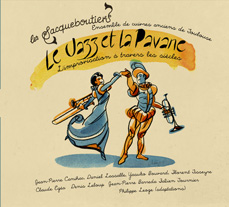
Les Sacqueboutiers Ensemble de cuivres de Toulouse. Le Jazz et la Pavane. Flora Productions (FLORADDD2812). Recorded April 2012. www.les-sacqueboutiers.com
Jean-Pierre Canihac; cornetto, Daniel Lassalle; sackbut, Yasuko Bouvard; organ, Florent Tisseyre; percussion. With Claude Egéa; trumpet, Denis Leloup; trombone, Jean-Pierre Barreda; bass, Philippe Lèogè; piano and arrangements.
This most recent recording of Les Sacqueboutiers de Toulouse is one of the most interesting and musically satisfying projects mixing early brass and jazz this reviewer has ever heard. In recent years there have been an increasing number of early brass performers playing jazz and contemporary music. There is actually a large and growing body of repertoire of modern music written for and performed by early brass musicians. In the jazz sphere the serpent virtuoso Michel Godard comes to mind. However, the focus of this recording was not to have early brass musicians perform jazz but to explore how jazz musicians can approach Renaissance and Baroque repertoire that is central to early brass performance.
There is much common ground from which to work. Firstly, improvisation is central to both musical traditions. The term is fraught with difficulty. Even in purely jazz discussion the concept of improvisation is widely debated. As explained by the legendary saxophonist Lee Konitz, improvisation, meaning truly spontaneous musical creation is a rare event. He claims that even for many renowned players what is being created is practiced material. This might be closer to the concept that early brass musicians employ when ornamenting lines with diminution patterns written in the famous ornamentation manuals and theoretical works of musicians such as Dalla Casa, Ortiz, Falconiero, Bismotova, Rognoni and others. Twelve compositions are played including ricercares by Diego Ortiz, a passacaglia and chaconne by Andrea Falconiero, works by Merula, Schütz, Juan Vasquez, Mateo Flecha and an anonymous Bombarde from a mass movement in the Apt manuscript.
A varied performance practice approach is used where sometimes the early brass players will start a work and “improvise” by using diminutions from the above mentioned manuals and then the jazz ensemble might take over using the melodic and rhythmic material of the piece as a basis for their improvisational interpretation. Other times the jazz ensemble may start, followed by the early brass and in other pieces, the two ensembles play together creating a wonderful group improvisation. Daniel Lassalle even makes up his own ornamental lines on the 2nd Ortiz Recercada. In addition to improvisation as a common musical element another strong shared musical feature is articulation. Lingua reversa as discussed by Dalla Casa is not far removed from typical doodle tonguing as used by jazz musicians such as trumpeter Clark Terry. This similarity is well borne out when listening to the combined performances on this recording.
The pitch on this recording is A=440 Hz. using equal temperament, except in the Rossi toccata, in which the harpsichord is mean tone and the piano equal temperament. On this recording Jean-Pierre Canihac plays a cornett by Delmas (he reported to me that now he is also playing instruments by Matthew Jennejohn at A=440 and A=465 Hz.) and Daniel Lassalle plays a Meinl sackbut. (This is one recording where it is particularly important to use the hotly debated name “sackbut” since the jazz ensemble employs a trombone and confusion could easily occur.) Jazz pianist, Philippe Lèogè, is credited in the liner notes as being the main musical force in seeing this project come to fruition. He orchestrated and arranged all the material and the results are spectacular. Both ensembles played with great sensitivity and showed that even with a span of 400 years the musicians found common musical ground and this wonderful CD is the outcome.
-- Jeffrey Nussbaum
[Editor's note: at the time of posting this CD was not yet listed on the record label's website]



